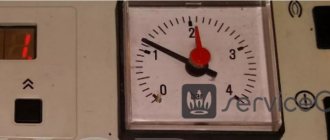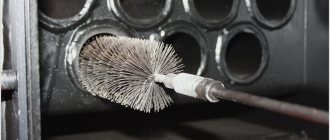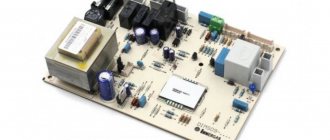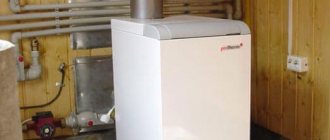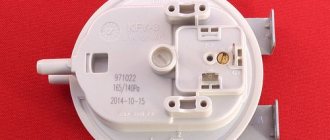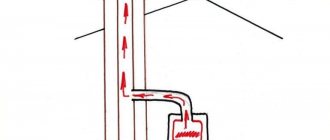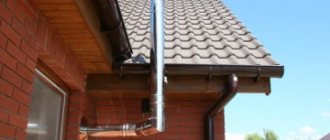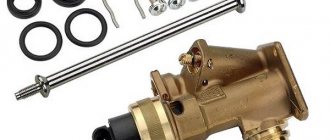The geyser is very popular among owners of apartments and private houses. Of course, the device does an excellent job of providing residents with hot water, does not require complex maintenance, and the cost of fuel used is minimal. But the water heater also has one serious drawback - a gas leak can lead to an explosion, destruction of the house and death. Therefore, it is extremely important to identify a breakdown in a timely manner and know how to check the draft in a gas water heater at home.
Each element of the device must work flawlessly, any problems must be corrected immediately, and failed parts must be immediately replaced. Regular checks of the system are carried out by gas service specialists, but you can periodically inspect some elements on which the safety of people living in the house depends on yourself.
We will try to figure out how to test the design, in particular, check the draft of the water heater, at home. In the article we will also consider effective ways to combat the lack of draft in the smoke duct.
The best ways to test traction
For correct operation of geysers with an open combustion chamber, you will need good draft and proper arrangement of the chimney. Most modern models are equipped with an automatic safety system that prevents the device from starting if there is no traction.
Next, we’ll look at how you can check the draft in the chimney of a domestic gas boiler and water heater.
Method #1 - using an anemometer
A professional check of the draft in the chimney of a gas boiler and water heater is carried out using a special measuring device - an anemometer.
With its help, you can verify the presence of air traffic and determine its strength. The indicator should be 1.96-29.40 Pa.
Method #2 - using a match
If it is not possible to use an anemometer, you can check as follows:
- Prepare paper strips and secure them at the entrance to the mine channel. You must first remove the horizontal part of the chimney pipe. The movement of part of the leaf will signal the presence of traction.
- Sufficient draft can also be determined using a flame. A lit match should be directed vertically towards the viewing window on the front panel of the water heater.
The chimney should be checked before igniting the water heater. A flame brought to the inspection hole at the top of the column during operation should be drawn inward.
It is necessary to check the draft in the gas water heater every time before turning on the device. Open the window slightly for air flow
Method #3 - checking the traction sensor
The water heater has several control modules installed. Sensors for overheating, draft, ionization, and water pressure prevent emergency situations.
The draft sensor monitors the temperature of the exhaust gases, and when it increases, it reacts accordingly:
- Inside the sensor there is a bimetallic plate connected to the gas valve.
- Metal expanding as a result of overheating transmits a signal to turn off the gas supply.
- The cooled plate returns to its original dimensions, opening the valve.
It is recommended to check the serviceability of the sensor when systematically turning off the column.
You can do this in several ways:
- place a mirror next to the sensor, its surface should not sweat when the water heater is turned on;
- The serviceability of the sensor will be indicated by turning off the gas water heater when the chimney is closed 2/3 with the damper.
In some water heater models, the regulator is mounted on a plastic mount that can be easily moved out of place. This will also lead to frequent speaker shutdowns.
You can also test the serviceability of the sensor using an ohmmeter; its resistance should be equal to infinity. Otherwise, the part should be replaced.
The sensor shuts off the gas supply in the event of a gas leak or poor removal of combustion products. The serviceability of the protective element is a guarantee of safe use of the water heater
When there is a constant interruption in the fuel supply, home owners often simply turn off the sensor, after which the water heater actually starts working without interruption. But such a decision violates the safety precautions for operating gas equipment. The water heater will remain unprotected; if there is a leak, carbon monoxide will enter the room.
It is strictly prohibited to use a gas water heater if there is no vacuum in the chimney channel. Let's consider the possible reasons for the lack of traction.
Features of internal installation of chimney pipes
Installation of chimney structures inside houses and premises has the following distinctive features and specifics:
- It is necessary to prepare areas for pipes in the roof and walls.
- The assembly of chimney structures is characterized by increased complexity, as well as repair work if necessary.
- The likelihood of toxic combustion products entering a living space is relatively high.
- It is necessary to carefully observe fire safety regulations and provide reliable protection for wooden elements and products.
First of all, markings are applied, and then, in accordance with it, holes of the required sizes are cut in the wall structures and roof. After this, the chimney structure is assembled, starting from the gas device.
The pipes are fixed to the walls using brackets and clamps. The section of pipe passing through the roof is protected using sheet metal. The connecting zones are insulated using heat-resistant sealant and insulation. The outer section of the pipe should end with a cone-shaped tip.
Reasons for lack of traction
The source of the malfunction can be identified by visually inspecting the column for errors made during its installation.
Violation of geyser installation technology, as well as the use of low-quality materials when installing a water heater are the main reasons for the lack of traction
There are several typical violations:
- The diameter of the air duct is less than the cross-section of the water heater outlet pipe.
- Using more than three repeat angles and adapters when installing a pipe.
- The chimney length is less than 2.5 meters.
- The chimney connections are loose and there are leaks.
- The distance from the water heater to the chimney is less than 30-50 cm.
- The length of the corrugation exceeds 2 meters.
It is also important to assess the compliance of the premises with technical operating conditions. It is prohibited to install a gas water heater and a forced exhaust hood in one room. When installing metal-plastic windows, supply valves must be used.
Main reasons for triggering
There are a number of main reasons why the controller may work, regardless of the type of combustion chamber installed in the gas installation.
You should not absolutely rely on the sensor's performance. Therefore, if possible, it is better to foresee negative scenarios in advance and eliminate the cause of their occurrence.
Gusty wind
To prevent a gust of wind from extinguishing the burner, experts recommend installing a stabilizer. It is mounted at the outlet pipe.
Incorrect installation
If errors were made in calculations or installation during installation. Carry out control measurements and check the correct installation of the boiler and chimney. The height of the outlet is calculated depending on the location of the pipe from the ridge. Experts recommend placing it in the center of the roof. The head is placed 50 cm above the ridge.
Disabling the fan
Turning off the fan stops the supply ventilation, and carbon monoxide is not discharged to the street. In this case, the reason for stopping the operation of the ventilation system is identified.
Experts recommend performing a seasonal preventive inspection of the heating device in the fall and spring. Operating the boiler without a thermostat is not recommended.
Poor quality traction
Poor quality traction is the main reason why the control sensor may work. This problem may arise due to improper design of the boiler and exhaust system. For example, poor-quality draft can be caused by a chimney with incorrectly calculated dimensions, if we are talking about a boiler with natural exhaust of combustion products, or a fan that does not operate at the required power, if it is a boiler with forced draft.
It is also worth checking the integrity of the output system. If the parts of the pipe are poorly connected to each other, the magnitude of the traction force will change.
Backdraft
Reverse traction force is a type of poor-quality traction. It is formed if a so-called air lock appears in the outlet system. If it is present, the gases that should exit through the outlet system to the street return back to the gas installation due to the fact that they cannot overcome the air lock.
This problem may arise due to poor thermal insulation (tightness) of the exhaust system pipes. As soon as the tightness of the pipe is broken, a temperature difference is formed, which provokes the appearance of an air lock.
To correct the problem of backdraft, you will have to repair the chimney.
Chimney blockage
A change in draft can also occur due to a clogged chimney. If its outlet is poorly protected from external influences, then, for example, foliage can get into it. But even good protection of the outlet does not guarantee its cleanliness. Birds can build a nest in a warm place and thereby affect the draft. But even the absence of birds does not guarantee good traction, because the output system can become contaminated with its own soot.
There is only one way out of the situation - regularly clean the chimney not only to eliminate problems, but also to prevent their occurrence.
How to increase draft in a water heater?
One of the main reasons for the lack of draft is a blockage in the smoke channel. This problem often occurs in old-type apartment buildings.
In the so-called Khrushchev buildings, 2 shafts are laid - for the water pump and for ventilation. First of all, you need to call specialists to carry out cleaning.
Removing the blockage in the smoke channel will help increase the draft in the water heater. You can clean it yourself using a metal brush or a special brush.
In a private house, improving draft should begin with an inspection of the chimney and assessing the contamination of the littered pipe. After removing the blockage, a mirror is placed inside the canal. There should be a light at the top of the chimney. It is recommended to carry out this procedure at least once every three years.
Poor draft can also be caused by improper installation of the chimney hood or a large number of unnecessary turns, sharp corners and bends in the pipe. If correcting errors made during installation did not help, you can increase the draft in the chimneys using smoke exhausters and fans.
Conclusions and useful video on the topic
How to extend the life of a gas water heater:
The gas heater goes out: what is the reason and how to troubleshoot:
Checking the draft in the smoke and ventilation ducts:
Checking the draft in the water heater is a prerequisite for the safe use of gas equipment. With the reverse movement of the ventilation stream, the flow of gases rushes into the room, which can lead to smoke and fire of surrounding objects. You can verify the presence of overturning traction yourself, without the involvement of specialists. It is enough to follow the recommendations given above.
Ways to eliminate backdraft
You should pay attention to any, even the most minor, changes in the operation of the gas device. If the water heater makes strange noises or turns on with a bang, you should immediately contact a specialist.
Popping noises are most common in older speaker models. In modern flow columns such defects are extremely rare. Extraneous sounds occur due to accumulated gas in the heat exchanger, which can subsequently occupy the entire chimney.
You can determine the presence of reverse draft in a gas column using measuring instruments. The indicator is set with maximum accuracy, in pressure units
In most cases, such a violation is provoked by a clogged chimney, a broken valve, or a deviation of the ignition wick.
In new water heater models, a malfunction can be caused by:
- defective spark plug;
- spent battery installed in the control module;
- faulty microswitch located in the water unit.
Having decided to carry out independent repair work, first of all, you need to check the intensity of traction using one of the methods listed above.
Further diagnostics will differ depending on the type of device - with an ignition wick or an automatic ignition system.
Column with automatic ignition system
In this type of water heater, the ignition device is controlled by an electronic module. The system with microswitches located on the fire and liquid regulators is considered one of the most reliable. Repairing a failed part can result in significant costs.
The operation of new generation geysers is based on the principle of automatic ignition. Such devices are equipped with several security sensors
You can determine the severity of the failure as follows:
- Research batteries . Delayed ignition of the gas may be due to a low battery charge. In this case, it is enough to replace the power source with a new one.
- Check the functionality of the liquid pressure microregulator , designed to transmit signals to the control module. Its activity is associated with the supply of water when it is necessary to ignite the gas. Like other regulators, it can fail and issue incorrect commands. The problem can be determined using an ohmmeter and a multimeter. The worn element should be replaced with a new one.
- The appearance of uncharacteristic sounds can also be caused by deformation of the location of the device that ignites the gas . The malfunction is usually caused by a temperature difference. The part is secured using a screw; you should loosen it a little and correct the position of the spark plug. The gap should be 0.4-0.5 cm.
- Gas can also accumulate due to a faulty valve, which causes fluid flow to slow down . The small metal ball should move freely under the lid. If its movement is disturbed, you can try to move the valve from its place with a cable. If there is contamination, the channel should be cleaned. But it is not recommended to carry out such a procedure unless absolutely necessary.
Upon completion of the repair work, it is necessary to check the connections for leaks. You can enhance safety using rubber gaskets and special sealants.
Ignition wick water heaters
Flow-through geysers of the previous generation often emit characteristic pops when turned on. Such structures are considered not very convenient and often even unsafe; at the same time, much less money will be needed to repair them.
You can eliminate gas pops by cleaning contaminants from the hole in the nozzle. The procedure must be carried out monthly or annually, depending on the quality of the fuel used
The accumulation of gas in an area not intended for this purpose can be caused by improper placement of the ignition wick. Failure to do so results in a reduced flame and an inability to reach the edge of the burner with the edge. The main reason for insufficient gas supplied to the wick is a clogged nozzle.
You can fix the problem yourself, but to do this you need to completely disassemble the device.
Be extremely careful when repairing the device; place all removed screws in a separate container so that they do not get lost. After removing the heat exchanger, take a photo of the location of the structural elements, this will help you later easily connect everything correctly
The first step is to turn off the water and gas supply.
The main part of water heaters has the same type of circuit, so the repair instructions will practically not differ:
- First you have to dismantle the protective casing of the water heater.
- Provide free access to the tee.
- Unscrew the fastening screws, and then remove the nuts securing the supply tubes and regulator.
- The tee must be carefully pulled out of the groove.
- Examine the lower pipe. A small screw with a through hole is the jet.
- The nozzle should be cleaned using a needle or wire.
- Upon completion of all work, you need to reassemble the water heater in the reverse order.
If the problem persists, you should contact a gas company specialist for help.
There are other reasons for the appearance of reverse thrust:
- Seasonal changes , in this case it is necessary to make sure that there are no errors when installing the chimney, and insulate the channels.
- An air lock inside the smoke channel can cause reverse draft in the chimney of a household gas water heater. To fix the problem, set fire to the newspaper inside the pipe.
- Forced exhaust in a room with a column causes a compensation process , air comes from the smoke duct. Metal-plastic windows only aggravate the problem; in some houses, air from the chimney begins to actively flow into the room.
We discussed more information about the causes of backdraft in a chimney in the next article.
A non-return valve can cause problems with the operation of the gas water heater. If the water heater begins to go out periodically, the reason is that the exhaust is blocked. In this case, you should contact a gas service specialist to check the chimney installation standards and, if necessary, reinstall the damper
The situation with air compensation can also be corrected using a check valve for the chimney of a gas water heater. You should also dismantle the fan and buy supply valves for metal-plastic windows.
Mechanical shut-off devices, known as a check valve or water heater damper, ensure that liquid and gas flow in only one direction.
Designed for turbocharged geysers. Their action is based on the opening of the exhaust hole when the column is operating and its closing after shutdown, which guarantees safe use.
How to check the draft sensor for a gas water heater: troubleshooting
- Operating principle of the sensor
- Functionality check
From the author: hello, friends! A geyser is a rather complex structure consisting of many elements. Each of them plays an important role in the operation of the device. If some of these elements break down, the problem is immediately visible and does not require any testing.
But how can I check the draft sensor for a gas water heater? And what is this part even needed for? This is exactly what will be discussed in today's article.
In general, a gas water heater is an excellent heating device. No wonder it is the most popular among owners of both apartments and private houses.
The boiler is highly efficient, does not require too much maintenance, and the fuel used usually costs literally pennies.
The only drawback of this equipment is the possible danger of its operation in the event of any malfunction. Everyone knows that a gas leak, for example, can have dire consequences, including an explosion, destruction of a house and death. Therefore, each element of the column must work perfectly, any problem must be corrected immediately, and a part that is absolutely faulty must be replaced.
Therefore, it is extremely important to detect a breakdown in a timely manner. To do this, regular checks of the system are carried out, and, as a rule, they are performed by gas service specialists. But you yourself can periodically inspect some elements on which the safety of the people living in the house depends. One such part of the design is the traction sensor.
Operating principle of the sensor
A gas boiler works by burning blue fuel. Naturally, combustion products are released. If they get into the room, this is fraught with severe poisoning of all residents of the house, even death.
Therefore, the design of the column provides for connection to a chimney, through which all harmful substances are discharged to the street.
Naturally, for high-quality exhaust, the ventilation shaft must have perfect draft. But it happens that some kind of violation occurs - for example, the chimney may become clogged with debris or soot.
If in such a situation the boiler stubbornly continues to burn fuel, then the combustion products will inevitably go into the house.
To prevent this, the design of the gas boiler includes an element such as a chimney draft sensor. It is located in the place between the ventilation duct and the equipment housing. The type of sensor depends on the type of boiler:
- in a boiler with an open combustion chamber, the protective sensor is a metal plate to which a contact is connected. This plate is the indicator that monitors the temperature increase. The fact is that normally released gases are usually heated to 120–140 degrees. If the outflow is disrupted and they begin to accumulate, then this value increases. The metal from which the plate is made reacts to this situation and expands. The contact attached to the element moves and closes the valve responsible for the gas supply. Thus, the combustion process stops, and at the same time the entry of a new portion of harmful substances is prevented;
- in a boiler with a closed combustion chamber, products are removed through a coaxial channel, and a fan is used. The sensor in this case is a pneumatic relay with a membrane. It reacts not to temperature, but to flow speed. While it is within acceptable limits, the membrane is bent and the contacts are in the closed position. When the flow rate becomes weaker than necessary, the membrane straightens, the contacts open, and this leads to the gas supply valve closing.
As you can see, if the draft sensor is triggered, turning off the gas water heater, this means some kind of malfunction in the operation of the equipment. For example it could be:
- initially poor quality traction. This is the first and main reason why the sensor may be triggered. As a rule, this phenomenon is associated with improper installation of the exhaust structure. If combustion products are poorly drawn out, then this poses a danger to all living things in the house;
- reverse thrust. This phenomenon occurs when an air lock forms in the chimney. Gases, which normally should move to the very top of the pipe and then exit, cannot overcome this obstacle and return back, filling the room. The reverse draft effect can occur if the chimney insulation is very poorly done. Temperature differences lead to the formation of air pockets;
- chimney blockage. Inexperienced owners may think that the pipe going to the roof simply cannot become clogged with anything. In fact, there are many factors that lead to the formation of a blockage. The first of these is birds. They can make nests on the pipe, which then fall down. And the birds themselves often manage to get stuck in the chimney and then die there. In addition to birds, you should also take into account the possibility of ingress, for example, of leaves, as well as soot deposits on the inner walls of the pipe. If the chimney is clogged, the draft intensity becomes too low, and there is only one way out - cleaning;
- strong wind. If the pipe is not positioned correctly, gusts can enter it and blow out the burner. Naturally, in such cases the sensor cuts off the fuel supply. To avoid such a danger, it is necessary to purchase and install a stabilizer.
Functionality check
All of the above can be combined into one whole: the sensor is necessary in order to shut off the fuel supply in the event of a danger - such as a gas leak or poor removal of combustion products. If this is not done, then very sad consequences are possible.
How to turn on a column
Let’s say right away that turning on a gas water heater with a closed chamber and automatic ignition is not difficult. But there is a rule that is important for heaters of all types when first started: the heat exchanger must be filled with water. Therefore, you need to open the water tap before and after the device, and then drain the water a little in the kitchen or other place. After this, the gas valve opens and the turbocharged unit is connected to the electrical network. Then she will do everything herself, you just need to adjust the temperature.
Another thing is a heater with an open chamber. In this case, in order to light the column, you must first turn on the igniter. To do this, open the gas supply valve and press the manual piezo ignition button, the wick is ignited by a spark. Next, the desired water temperature is set using regulators or buttons, while the igniter remains lit. As soon as a hot water tap opens somewhere, the main burner will start from it.
If the device has an automatic battery-powered ignition system, then the start-up algorithm is as follows:
- insert batteries into the compartment;
- open the gas tap;
- open the water valves;
- Unscrew the nearest hot water tap a few turns and thereby light the main burner. The intermediary is the igniter, which is turned on only when the burner is starting.
At the first start-up or after a long break, an air plug forms in the gas pipe at the entrance to the device. You can remove it by repeating the ignition operation several times.
Terms of use
Any gas-using installation is a priori considered a source of increased danger, and instantaneous gas heaters are no exception. For this reason, they are subject to all rules for handling household gas equipment. So, if you smell gas in the room, then:
- immediately turn off the valve installed in front of the equipment;
- open the windows for ventilation;
- do not use electrical appliances, do not turn on (or turn off) the lights, do not smoke;
- call the gas service.
Typically, the rules for using a gas water heater are set out in the operating instructions that come with it. We will present them again, since compliance with these rules is the key to the safety of all people living in a house or apartment. This is especially true for those homeowners in whose homes chimney-type water heaters are installed:
- Only a specialized organization that has the appropriate permits has the right to install and connect the device. The basis for performing work is considered to be design documentation approved by the fuel supplier;
- It is prohibited to start the heating device when there is no draft in the chimney;
- do not turn on or adjust the column without reading the operating instructions;
- it is necessary to ensure a flow of fresh air into the room where the unit is located;
- changes to the design are not allowed;
- While the heater is operating, avoid touching the front panel near the inspection slot and open parts of the chimney pipe.
Now let’s talk about how to extend the life of your water heater. The heat exchanger is one of the most expensive elements of the installation, on the surface of which scale forms when the hot surface comes into contact with running water. Based on this, using the column correctly means protecting the heat exchanger from scale in all available ways.
You should not set the maximum heating temperature; in most devices it is 70 ºС, and the minimum is 30 ºС. For example, the instructions for the Russian-made NEVALUX unit states that the optimal operating temperature is 45-50 ºС. In this case, it is recommended to limit the flow through the column using a special control valve. The goal is simple: to reduce sudden pressure changes in the device when opening taps of various consumers.
How to use the equipment?
Without violating the operating rules, you can significantly extend the service life of gas appliances:
• Do not turn on the boiler with a broken burner or a clogged chimney.
• The chassis must be grounded.
• When using antifreeze as a coolant instead of water, you need to purchase only a certified product. Containing ethylene glycol is prohibited.
• Water should not heat above 95 degrees.
• When installing the device near a wall that is covered with a fire-hazardous material, it is necessary to make a gasket made of steel or asbestos.
• The device may only be turned on after the system has been filled with water/antifreeze.
• Clean your chimney and filters annually. Make sure all connections are tight.
How to troubleshoot
If a fault is detected in the gas boiler draft sensor itself, it is replaced with a new one. If a break or fault in the electrical wiring was detected using the tester, the corresponding section of the wire must be replaced or repaired.
After performing the above steps, it is necessary to re-check the operation of the boiler and the draft sensor by forcing it.
It is important to note that during the operation of any type of boiler, its periodic maintenance is mandatory and recommended by the manufacturer. It includes checking the electronic control unit, control devices, as well as the mechanical parts of the boiler. In addition, the components of the boiler and chimney are cleaned from accumulated combustion products.
For this purpose, qualified workers with appropriate education and diagnostic equipment corresponding to the characteristics of a particular type of boiler are involved.
Design and principle of operation of the sensor
Considering the variety of designs of gas boilers, it should be noted that draft control sensors are also found in different designs. If we consider their design in an extremely general way, we will talk about a fairly simple mechanism of devices.
The basis of almost any gas boiler draft control sensor is a bimetallic element that changes shape with changes in the temperature background. In fact, it is a simple bimetallic strip that bends when heated or cooled.
Changing the shape of the plate controls the contact group, which switches the state of the contacts to “on” or “off”. The switching signal of the contact group is transmitted to the gas boiler controller or to a simpler gas supply control mechanism.
The type of sensor that controls draft in the smoke channel depends on the boiler used.
So, there are two types of gas boilers that exist and are used in practice:
- Structures equipped with a simple chimney (with natural draft).
- Structures equipped with a chimney with a turbine (with forced draft).
These designs differ from one another and the traction sensors used for them also differ.
Devices for natural draft boilers
Natural draft boilers use a so-called flue gas hood, into the body of which a simple miniature thermostat is built, as shown in the picture below.
A thermostat of a simple design in a miniature design is usually equipped with a corresponding temperature mark directly on the body (on the metal shell). This mark (for example, 75º) indicates the temperature limit for the sensor contact group to operate.
A thermostatic device of this design is installed, as a rule, as part of the designs of wall-mounted gas boilers, where a flue gas hood built into the chimney line is used
This device works simply. If the flue gases passing through the hood with the installed sensor heat the device above the set temperature parameter (which indicates a violation of the draft mode), the contacts will open the circuit.
Accordingly, due to an open circuit, the gas supply system to the boiler will be switched off (blocked). The equipment will restart only after the sensor has cooled down and the open contact has been restored.
Turbine boiler sensor designs
Boilers equipped with a chimney with a turbine have a slightly different sensor for determining the draft of a gas boiler with an operating principle that differs functionally. First of all, the difference is that the sensor actually controls the boiler turbine fan. In other words, the optimal draft of flue gases by the fan is controlled.
That is why the design of draft sensors for turbine gas boilers is not designed to control temperature, but to control the volume of passing carbon monoxide.
Such sensors operate based on the presence of optimal vacuum inside the combustion chamber and have a contact group of three elements:
- contact COM;
- normally open (NO);
- Normally closed (NC).
Structurally, the devices are made in different shapes, but their principle of operation remains unchanged. Upon the formation of operating conditions inside the gas boiler chamber (optimal vacuum), the supplied air pressure closes the contact group, sending a signal to supply gas.
A slightly different type of sensor elements designed to control draft in the boiler - designs whose operating principle is based on the difference in pressure of the outgoing flow


